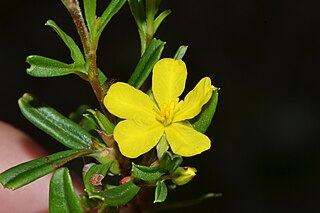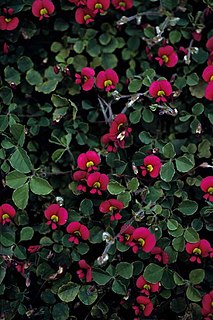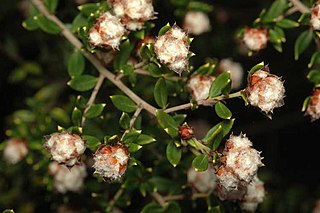
Hibbertia stellaris, commonly known as star guinea flower or orange stars, is a brilliantly orange flowering ground cover from the South Western Australian botanical province. It naturally grows in swamps; despite this, it is extremely sensitive to phytophthora and needs to be grown in well-drained soil in cultivation.

Hardenbergia is a genus of three species of flowering plants in the pea family, Fabaceae and is endemic to Australia. Plants in this genus are climbing or trailing herbs or subshrubs with pinnate leaves with one, three or five leaflets and groups of violet, white or pinkish flowers in pairs or small clusters in leaf axils. Species of Hardenbergia occur in all Australian states and in the Australian Capital Territory.

Chorilaena quercifolia, commonly known as karri oak or chorilaena, is a species of bushy shrub that is endemic to the karri forests of south-west Western Australia. It is the sole species in the genus Chorilaena. It has papery, broadly egg-shaped leaves with lobed edges and variously-coloured flowers arranged in umbels of five, the sepals and petals hairy on the outside and the stamens protruding beyond the petals.
Enumeratio plantarum quas in Novae Hollandiæ ora austro-occidentali ad fluvium Cygnorum et in sinu Regis Georgii collegit Carolus Liber Baro de Hügel is a description of the plants collected at the Swan River colony and King George Sound in Western Australia. The author, Stephan Endlicher, used a collection arranged by Charles von Hügel to compile the first flora for the new settlements. Hugel visited the region during 1833–1834, several years after the founding of the colony. The work provided formal descriptions, in Latin, of new species and genera of plants. The single instalment was produced in Europe by Endlicher in 1837, the work also included contributions by Eduard Fenzl, George Bentham, Heinrich Wilhelm Schott.

Gompholobium huegelii, commonly known as common wedge-pea is a species of flowering plant in the family Fabaceae and is endemic to south-eastern Australia. It is an erect or spreading shrub with trifoliate leaves and cream-coloured to yellow and greenish, pea-like flowers.

Boronia cymosa, commonly known as granite boronia, is a plant in the citrus family Rutaceae and is endemic to the south-west of Western Australia. It is an erect shrub with linear, more or less cylindrical leaves and groups of relatively small, pink four-petalled flowers arranged on branched flowering stems.
Hemiandra linearis, commonly known as speckled snakebush, is a species of prostrate to ascending shrub that is endemic to the south-west of Western Australia.

Comesperma integerrimum is a twining shrub or climber in the family Polygalaceae.

Goodenia fasciculata is a species of flowering plant in the family Goodeniaceae and is endemic to the south-west of Western Australia. It an ascending shrub with bunched, narrow linear stem leaves and spikes of white flowers.

Goodenia pulchella is a species of flowering plant in the family Goodeniaceae and is endemic to the south-west of Western Australia. It is an erect to ascending herb with lance-shaped leaves mostly at the base of the plant, and racemes of yellow flowers.

Gompholobium aristatum is a species of flowering plant in the family Fabaceae and is endemic to the south-west of Western Australia. It an erect shrub that typically grows to a height of 10–80 cm (3.9–31.5 in). It flowers between July and December producing yellow, pea-like flowers. This species was first formally described in 1837 by George Bentham in Stephan Endlicher's Enumeratio plantarum quas in Novae Hollandiae ora austro-occidentali ad fluvium Cygnorum et in sinu Regis Georgii collegit Carolus Liber Baro de Hügel from specimens collected in the Swan River Colony. The specific epithet (aristatum) means "awned", referring to the leaves.

Hibbertia perfoliata is a species of flowering plant in the family Dilleniaceae and is endemic to Western Australia. It is a weak, ascending or prostrate, spreading shrub that typically grows to a height of up to 40 cm (16 in). It flowers from September to December or from January to March and has yellow flowers. The species was first formally described in 1837 by Stephan Endlicher from an unpublished description by Charles von Hügel and Endlicher's description was published in his book Enumeratio plantarum quas in Novae Hollandiae ora austro-occidentali ad fluvium Cygnorum et in sinu Regis Georgii collegit Carolus Liber Baro de Hügel. The specific epithet (perfoliata) means "perfoliate".

Hibbertia racemosa, commonly known as stalked guinea flower, is a species of flowering plant in the family Dilleniaceae and is endemic to the south-west of Western Australia. It is an erect or ascending, spreading shrub that typically grows to a height of 10–75 cm (3.9–29.5 in) and produces yellow flowers between July and December.

Kennedia carinata is a species of flowering plant in the family Fabaceae and is endemic to the south-west of Western Australia. It is a prostrate shrub with trifoliate leaves and reddish-purple, pea-like flowers.

Lechenaultia floribunda, commonly known as free-flowering leschenaultia, is a species of flowering plant in the family Goodeniaceae and is endemic to the south-west of Western Australia. It is an openly-branched shrub or subshrub with crowded, narrow, fleshy leaves and compact groups of pale blue to pale mauve or creamy white flowers.
Lasiopetalum cordifolium, is a species of flowering plant in the family Malvaceae and is endemic to the south-west of Western Australia. It is an erect shrub with hairy stems, heart-shaped leaves and pink, cream-coloured or white flowers.

Sphaerolobium alatum is a species of flowering plant in the family Fabaceae and is endemic to the south of Western Australia. It is a slender, leafless shrub with yellow and reddish-brown flowers from September to November.
Sphaerolobium fornicatum is a species of flowering plant in the family Fabaceae and is endemic to the far south-west of Western Australia. It is a leafless shrub that typically grows to a height of 0.1–1 m and has yellow or orange and red flowers from October to January.

Sphaerolobium linophyllum is a species of flowering plant in the family Fabaceae and is endemic to the south of Western Australia. It is a prostrate to ascending shrub with a few narrowly linear leaves and red, yellow and orange flowers.

Spyridium buxifolium is a species of flowering plant in the family Rhamnaceae and is endemic to New South Wales. It is a spreading shrub with egg-shaped to elliptic leaves, and heads of white, softly-hairy flowers with brown bracts at the base.
















